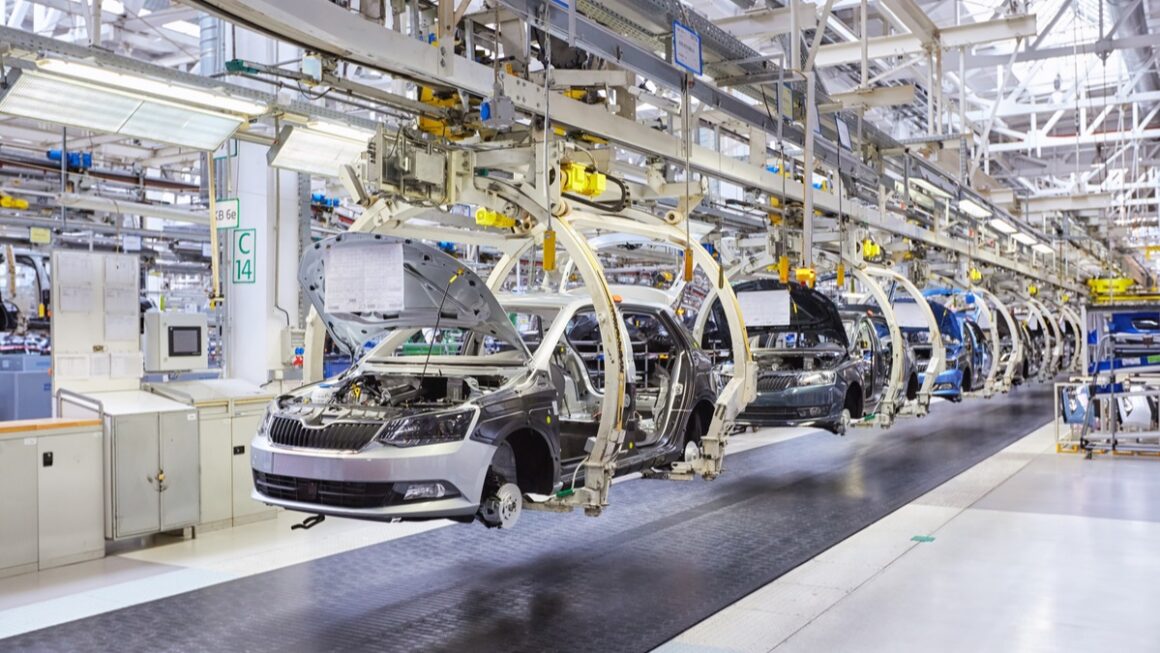By Bill Hopwood, Socialist Alternative, our sister organisation in Canada
Just-in-time production was a key part of the process of neoliberalism and globalization, as part of the drive to maximize profits. First used in Japan in the 1970s, it spread around the world and beyond manufacture to almost every facet of capitalist economics and management systems.
The core idea is that manufacturers do not hold supplies of parts and raw materials. Instead, these are delivered just in time for when they are to be used. This saves the costs of storage — the land and building for a warehouse and the cataloguing and management of the stored materials.
However, the system requires many components. It needs reliable suppliers and logistics so that the materials do arrive on time and in the amount required. It needs accurate monitoring of the stocks on hand, so no component runs out. It relies on a predictable or accurate knowledge of demand so that the right components are available to meet that demand. Originally in Japan the supply chains were short, with the makers of components close to the final assembly plant.
The collapse of Stalinism and the opening of China to world trade and its transformation into a capitalist economy allowed just-in-time supply chains to stretch around the world to exploit lower labour costs. For this to work, the widespread adoption of containers was required, which makes the shipping of goods much cheaper and faster than when bulk cargo was loaded into ships. Computers and bar codes allowed more reliable tracking of goods. The long supply lines with many components, all arriving just in time, feeding into the final production, requires a workforce that does not disrupt the constant movement of goods.
Just-enough rather than just-in-case
The methods of just-in-time spread from manufacturing to most facets of life. Retailers carried minimum stocks, relying on a constant stream of deliveries.
As the neoliberal ideas that even public services should operate on models of profit — internal markets in health for example — the ideas of just-in-time spread to services. Before, as reliability of service had been the priority, some spare capacity was built into the system, just in case of unforeseen problems. The just-enough system stripped out spare capacity to run “lean.”
Hospitals reduced spare capacity that been there to deal with emergencies. Canada slashed the number of acute hospital beds from 4.99 acute beds for every 1,000 people in 1976 to only 1.96 in 2018. Hospitals, even in northern rich countries, before COVID, had a crisis every winter as flu cases shot up.
At one time, public transport providers had stand-by spare crews to cover for sickness and other unforeseen events. To the managers and accountants who increasingly ran these services, it was a wasteful expenditure to pay workers to be on stand-by. Staffing levels were reduced to just-enough.
A still-ticking time bomb due to just-enough is the long running failure of many countries and companies to invest in maintenance. Decision makers didn’t see the reason to spend money on infrastructure and maintenance that could go to profits or tax cuts to the rich. Why do something today that can be put off to tomorrow? The lack of maintenance was left as a problem for the future. But that future is increasingly approaching. US public investment in infrastructure has fallen as a share of GDP by more than 40 percent since the 1960s. Now nearly one in four road bridges in the US are deficient. The cost of fixing the backlog of repairs is now over $1trillion.
In the summer of 2022 large parts of England were under drought restrictions on water use. Yet nearly a quarter of all the water is lost in the leaking pipes. The privatized water companies make big profits, paying out dividends of £72 billion between 1989 and 2021, partly raised by starving the system of maintenance. At current rates of replacements, it will take 2,000 years to replace all of England’s water pipes, pipes that are expected to last 100 years at most.
Canada’s rail freight is vital to the economy according to the government, having legislated striking workers back to work multiple times. Yet the private companies, Canadian Pacific and Canadian National, are allowed to underinvest in maintaining the network. Freight trains travel at an average speed of 39 kilometres an hour, and much slower across the Rockies. In 2019 there were 78 main-track derailments, and 5 workers were killed and 15 seriously injured. Some of the derailments have spilled toxic chemicals and caused fires. In 2022 CP announced annual profits of $6.6 billion while CN’s was $4.9 billion.
For decades investment in skills by government and business has been cut back. Once employers paid workers to gain skills, either through paid apprenticeships or on-the-job training and governments paid for most of the cost of university degrees. Now it is mostly young people and workers that pay for education and training, piling up debt. There was a myth that society did not need skilled workers, it was all about the “knowledge economy.” However, humans live in an analogue world with material plumbing and houses, eat material food and travel in material vehicles. For years companies underinvested in training skilled workers, relying on the existing pool of workers, and now 700,000 skilled trades will retire by 2028. Canada is facing a shortage of 55,000 truck drivers.
In Canada it takes eight years of university to become a doctor, costing between $200,000 and $300,000 for university fees, books and living expenses. Only 5.5 percent of applicants get into Canadian medical schools. In the US it costs more and in Britain it takes longer. No wonder there is a shortage of doctors and other medical workers.
Everywhere, the systems, networks and employment policies that had some spare capacity just in case, were stripped to the minimum to operate in “normal” times. However, the world is full of the unexpected. When one ship, the Ever Given, ran aground in the Suez Canal, it disrupted one of the world’s busiest trade routes, halted some 450 ships and cost $10 billion.
And what about the workers?
Just-in-time and just-enough relied on a compliant workforce often with every working minute managed. Workers have keystrokes on their computers monitored, call centre workers are reprimanded if they take a break or spend too long conversing with customers. Amazon is one of the most extreme examples of this process with workers’ every move monitored by electronic spy gadgets that “watch” their hand movements. In just-in-time every second is measured. Marx wrote capitalism makes a worker the “appendage of the machine.” In an Amazon warehouse a worker is the “puppet of the machine” — their every move controlled.
Long distance truck drivers have to sleep in the cab at the side of the highway to keep to the just-in-time schedules and because of the lack of rest areas. Bus drivers have to pee into a bottle to keep to the impossible just-in-time schedules. Tech workers often put in crazy long hours to meet an impossible timetable that the company has set for delivery of some software or product.
Even with claimed shortage of workers and soaring inflation most employers are still reluctant to agree on wages that raise living standards or improve working conditions.
Environment costs
Just-in-time, along with global supply chains, needs a ceaseless movement of resources, parts and goods carried in ships, trucks, airplanes and trains. Almost all rely on fossil fuels. Shipping alone contributes 3 percent of global CO2 releases and road freight twice as much.
As well as CO2, trucks largely use diesel and shipping burns bunker fuel, two dirty forms of oil that produce many pollutants including sulfur dioxide, nitrous oxide and small particulates — all dangerous to human and animal health.
Shipping is noisy — disorientating many marine animals that use sound to communicate, find food and navigate. Shipping-kill is widespread: whales, sharks and turtles are all victims. Roadkill from freight is common but not well recorded. It is estimated that in the US alone, 1 million animals are killed on roads, every day. Most roadkill is outside of big cities and at night, places and times with a high proportion of trucks — driving at night for just-in-time, not the health of truckers.
Ports are built in areas once rich in life, often where rivers meet the sea. Wide highways devour land, place barriers to animals and create noise pollution.
Then came COVID
COVID hammered this entire approach. Supply chains were disrupted, demand for some goods and services collapsed while in other sectors demand exploded. Workers were sick or isolating at home.
Capitalism, in its drive to maximize short-term profits, had removed all spare capacity, leaving the world economy and humanity extremely vulnerable.
Governments had reasoned there was no need to stockpile health and protective equipment as it might not be needed. Why “waste” money just in case?
Suddenly governments “discovered” they had no capacity to make PPE, masks or pharmaceuticals; it had been outsourced to be delivered just in time. But the governments of countries with production capacity were putting their national interests first. Vaccine nationalism and vaccine imperialism were born.
Containers were suddenly in short supply or were stranded in the wrong places. Even a small disruption to just-in-time would cascade across networks, workplaces and systems. Car factories stopped production as critical parts had not arrived. A particularly sharp pinch in supply was microprocessor chips, that now are ubiquitous in many products.
MAKE.UK, the umbrella organization of British manufacturers reported that 60 percent of companies saw supply chain problems as their biggest risk. A recent report stated that the “‘just in time’ process with virtually guaranteed transport links and low-cost production, had been turned upside down with disruption and increased volatility fast becoming normal.”
Hospitals that had operated with just-enough before COVID were swamped. Most health systems barely survived and at the cost of delaying treatment of many non-COVID patients, in some cases with serious consequences for those people. Now, nearly three years after the start of COVID, hospitals and workers are still being over-stretched as COVID continues to circulate alongside flu and an alarming increase in respiratory syncytial virus (RSV) in children.
Across the sectors that continued to operate during COVID, the “essential services,” workers had to put in hours of overtime to make up for the previous lack of spare capacity and staff, as well as deal with the added challenges of COVID and fellow workers getting ill.
Now that restrictions to prevent the spread of COVID have largely been removed, bosses are complaining about labour shortages. In some cases, it is really a shortage of good pay and conditions. Workers have decided that there is more to life than working long hours for lousy pay and putting up with a bad boss. There is a long-term lack of skilled workers, due to low levels of training, with many looking to retire.
In other cases, it is due to burnout after nearly three years of being “essential” and therefore overworked. There are still elevated levels of COVID illness as it is still running through society. Now with China easing three years of draconian COVID restrictions, there is a fear it will spread rapidly and further disrupt manufacturing and world supply chains.
Three years after COVID first emerged, it continues to disrupt supply chains, the world economy and humans’ lives. Capitalism, in its search for quick profits, made global society highly vulnerable to any stress.
There is a growing trend of near-shoring and friend-shoring, instead of just-in-time global supply chains. This is a response to the disruption of COVID and the mounting geo-political conflict between the US and China.
Workers do have power
The experience of COVID demonstrated to many workers that they are needed for society to function. A key group of workers are those in logistics, at ports and airports, in ships, trucks and trains, and in warehousing and distribution.
The scandalous role of Biden and the Democrats in ordering US rail workers back to work shows the power these workers have. Amazon’s entire economic model relies on the super-control and exploitation of workers. If Amazon workers unionize and gain some control over their working conditions, Jeff Bezos will no longer be so filthy rich. The convoy in Canada blocked the Ambassador Bridge between Windsor and Detroit for six days and cost billions of dollars in business.
Workers will draw lessons and build their power to fight for better pay and conditions. As struggles develop, the idea of running society just-in-time and with just-enough to make profits will be seen increasingly as misguided. It will be replaced by the idea of running society to meet human needs and protect the environment. These ideas are at the core of socialism.












